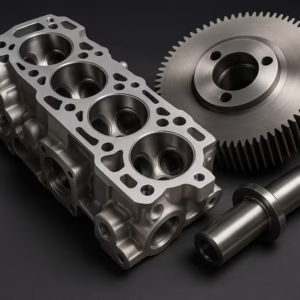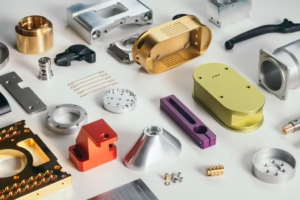What Are The Different Types of Steel
What is steel?
Steel is the backbone of modern industry and is quite possibly the most versatile alloy used in contemporary production. Steel is an iron alloy consisting primarily of iron and carbon-carbon being the non-metallic alloying element that clearly distinguishes iron from steel. The carbon content of steel ranges from 0.002% to 2.14%, which is higher than in wrought iron and lower than in cast iron.
Granted, this is only a small amount of carbon by weight, but it significantly enhances the physical properties of steel, making it harder and stronger than pure iron. In its most basic form, steel is typically made of iron and carbon, with other elements present in negligible amounts – this is known as carbon steel.
However, the addition of other alloying elements, such as chromium, nickel, manganese, and vanadium, can further enhance its properties. This steel is primarily used in the construction industry and in the production of industrial hardware, such as knobs and handles, which do not have specific requirements for tensile strength.
What Are the Different Types Of Steel?
Steel is classified by its composition: iron is fused with carbon and any number of other elements to achieve a specific end. The four main types are:
- Carbon steel
- Stainless steel
- Alloy steel
- Tool steel
Carbon steel
Carbon steel is a steel alloy that primarily consists of iron and carbon, with a carbon content ranging from 0.05% to 2.0%. It may also contain small amounts of manganese, silicon, and copper. It is widely used in construction, automotive, and industrial applications due to its strength, affordability, and versatility.
✅ Key Characteristics of Carbon Steel
- High Strength and Durability: Suitable for structural applications.
- Cost-Effective: Less expensive compared to stainless and alloy steels.
- Magnetic Properties: Carbon steel is ferromagnetic.
- Corrosion Prone: Requires protective coatings or treatments.
Types of carbon steel
1、 Low Carbon Steel (Mild Steel)
Carbon Content: 0.05% – 0.25%
Características:
Soft, ductile, and easy to machine or weld.
Low tensile strength but excellent formability.
Applications:
- Construction materials (beams, pipes)
- Automotive body panels
- Household appliances
2、Medium Carbon Steel
Carbon Content: 0.25% – 0.60%
Características:
Higher strength and hardness than low-carbon steel.
Reduced ductility and weldability.
Applications:
- Machinery parts
- Gears, axles, and crankshafts
- Structural applications
3、High Carbon Steel
Carbon Content: 0.60% – 2.0%
Características:
Very hard and wear-resistant.
Low flexibility and brittle nature.
Applications:
- Cutting tools (drills, saw blades)
- Springs and wires
- High-strength wires and cables
Stainless steel
Stainless steel is an alloy of iron with a minimum of 10.5% chromium, which forms a thin, protective oxide layer on the surface, making it resistant to corrosion. It is widely used in the automotive, medical, food, and aerospace industries due to its durability and aesthetic appeal.
✅ Key Characteristics of Stainless Steel
- Corrosion and Rust Resistance: Ideal for harsh environments.
- High Strength and Toughness: Suitable for structural applications.
- Non-Magnetic or Magnetic: Depending on the alloy composition.
- Aesthetic Appeal: A polished finish makes it popular in decorative applications.
Types of stainless steel
1、Austenitic Stainless Steel (300 Series)
Composition: High chromium (16-26%) and nickel (6-22%).
Características:
Excellent corrosion resistance.
Non-magnetic and easily weldable.
Applications:
- Food processing equipment
- Medical instruments
- Kitchen Appliances
2、Ferritic Stainless Steel (400 Series)
Composition: Chromium (10.5-27%) with low or no nickel content.
Características:
Good corrosion resistance.
Magnetic and less expensive than austenitic steel.
Applications:
- Automotive parts (exhaust systems)
- Industrial equipment
- Home appliances
3、Martensitic Stainless Steel
Composition: Chromium (11-18%) with low nickel.
Características:
High strength and hardness.
Moderate corrosion resistance.
Magnetic.
Applications:
- Surgical instruments
- Knives and blades
- Shafts and fasteners
4、Duplex Stainless Steel
Composition: Balanced mix of austenitic and ferritic structures.
Características:
High strength and corrosion resistance.
Resistant to stress corrosion cracking.
Applications:
- Chemical processing equipment
- Marine and offshore applications
- Heat exchangers
Alloy steel
Alloy steel is a type of steel with iron, carbon, and additional alloying elements such as manganese, chromium, nickel, molybdenum, or vanadium. These alloying elements enhance the strength, toughness, and corrosion resistance of the steel.
✅ Key Characteristics of Alloy Steel
- Improved Strength and Toughness: Ideal for heavy-duty applications.
- Corrosion and Wear Resistance: More durable than plain carbon steel.
- Better Heat Resistance: Suitable for high-temperature applications.
- Enhanced Machinability: Easier to process and shape.
Types of alloy steel
1、Low-Alloy Steel
Alloying Elements: < 5%
Características:
Improved strength and toughness.
Enhanced weldability.
Applications:
- Structural steel components
- Pressure vessels
- Oil and gas pipelines
2、High-Alloy Steel
Alloying Elements: > 5%
Superior corrosion and wear resistance.
High heat resistance.
Applications:
- Aerospace and aircraft components
- Power plants
- Industrial tools
3、Chromoly Steel (Chromium-Molybdenum Steel)
Alloying Elements: Chromium and molybdenum
Características:
High strength-to-weight ratio.
Excellent resistance to fatigue and corrosion.
Applications:
- Bicycle frames
- Motorsports components
- Aircraft parts
Tool steel
Tool steel is a variety of carbon and alloy steel specifically designed for making tools. It offers superior hardness, wear resistance, and toughness, making it ideal for cutting, molding, and shaping applications.
✅ Key Characteristics of Tool Steel
- High Hardness: Withstands impact and friction.
- Wear and Abrasion Resistance: Maintains sharpness under repeated use.
- Heat Resistance: Can endure high temperatures without losing hardness.
- Excellent Machinability: Easily shaped into precision tools.
Types of tool steel
1、Water-Hardening (W-Grades)
Hardening Medium: Water
Características:
High hardness but lower wear resistance.
Less expensive.
Applications:
- Hand tools (chisels, hammers)
- Low-cost cutting tools
2、Cold-Work Tool Steel (A, D, and O-Grades)
Hardening Medium: Oil or air
Características:
High wear resistance and hardness.
Used at low working temperatures.
Applications:
- Dies and punches
- Stamping tools
- Shear blades
3、Hot-Work Tool Steel (H-Grades)
Hardening Medium: Oil or air
Características:
High heat resistance.
Retains hardness at elevated temperatures.
Applications:
- Die casting molds
- Extrusion tools
- Hot forging dies
4、High-Speed Steel (HSS)
Alloying Elements: Tungsten, molybdenum, vanadium, and cobalt.
Características:
Extremely high hardness and heat resistance.
Maintains cutting edge at high speeds.
Applications:
- Drill bits
- End mills
- Lathe tools
5、Shock-Resistant Tool Steel (S-Grades)
Características:
High toughness and impact resistance.
Moderate hardness.
Applications:
- Jackhammer bits
- Shear blades
- Impact tools
Steel Grades and Standards
According to the World Steel Association, there are more than 3,500 different grades of steel. At its core, steel is made up of iron and carbon, but the carbon content, the amount of impurities, and other alloying elements all affect the grade of steel. Each steel has unique properties and typical end uses.
Two grading systems for steel.
ASTM (American Society for Testing and Materials): Alphanumeric classification indicating the overall classification and specific properties of steel.
SAE (Society of Automotive Engineers): Four-digit classification highlighting the type of steel and carbon content and the presence of other alloying elements.
What is the difference between stainless steel and mild steel
The term steel covers a wide range of metals that can be divided into stainless steel and mild steel. Although the two terms stainless steel and mild steel themselves cover a large number of different metals, there are some key characteristics between the two.
Mild Steel vs Stainless Steel
Main Alloying Elements
This is the main factor that distinguishes mild steel from stainless steel. Mild steel uses carbon to make its alloy, while stainless steel uses chromium as an alloying element. These two different alloys produce very different results in terms of corrosion resistance, ductility, ease of manufacturing, and cost. It is this key difference that sets these two different steels apart.
Se o senhor tiver alguma necessidade, entre em contato conosco pelo e-mail Lynnyao@prototekparts.com ou telefone: +86-0792-86372550
Tags:
- Aço

























































